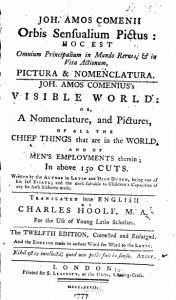PDF #60 – Joh Amos Comenii – Orbis Sensualium Pictus

Orbis Sensualium Pictus (Visible World in Pictures), is a textbook for children written by Czech educator John Amos Comenius and published in 1658. It was the first widely used children’s textbook with pictures, published first in Latin and German and later republished in many European languages. The revolutionary book quickly spread around Europe and became the defining children’s textbook for centuries.
Comenius introduced a number of educational concepts and innovations including pictorial textbooks written in native languages instead of Latin, teaching based in gradual development from simple to more comprehensive concepts, lifelong learning with a focus on logical thinking over dull memorization, equal opportunity for impoverished children, education for women, and universal and practical instruction. Besides his native Bohemian Crown, he lived and worked in other regions of the Holy Roman Empire, and other countries: Sweden, the Polish–Lithuanian Commonwealth, Transylvania, England, the Netherlands and Hungary.
John Amos Comenius was born in 1592 in the Margraviate of Moravia in the Bohemian Crown. His birthplace is uncertain and possibilities include Uherský Brod (as on his gravestone in Naarden), Nivnice, and Komňa (from this village he took his surname, which means “a man from Komňa”), all of which are located in Uherské Hradiště District of today’s Czech Republic. John was the youngest child and only son of Martin Komenský (died 1602–4) and his wife Anna Chmelová. His grandfather, whose name was Jan (János) Szeges, was of Hungarian origin. He started to use the surname Komenský after leaving Komňa to live in Uherský Brod. Martin and Anna Komenský belonged to the Moravian Brethren, a pre-Reformation Protestant denomination, and Comenius later became one of its leaders. His parents and two of his four sisters died in 1604 and young John went to live with his aunt in Strážnice.
After reading “Joh Amos Comenii – Orbis Sensualium Pictus” you can check important issues for ESL teachers on the section PDFs, and visit my Youtube channel.

